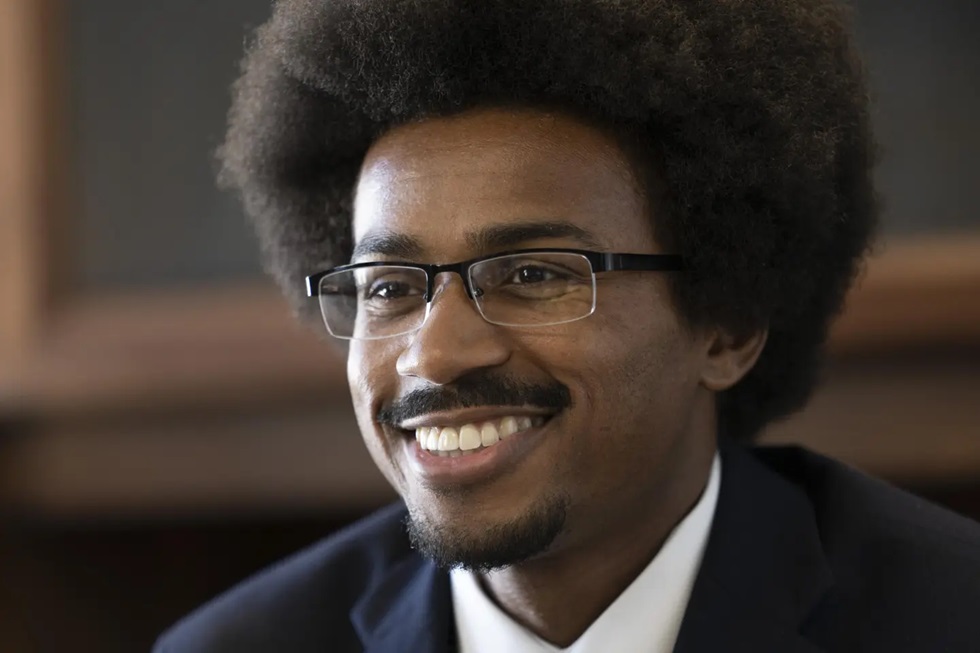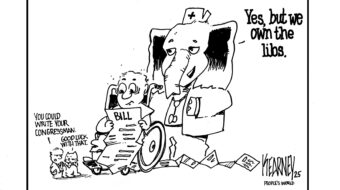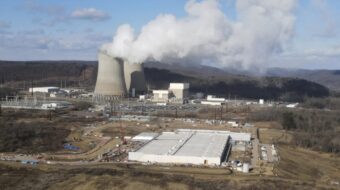
“On the November ballot is whether we will have clean air and water for everybody no matter where they live, and clean soil to plant in. Whether kids will stop dying from asthma, and pipelines will stop being built across our states,” declared Tennessee State Representative Justin Pearson. “And if we’ll have a climate and environment that is just.”
Pearson, one of the Tennessee Three, was speaking on August 21 before the Environmental and Climate Crisis Council at the Democratic National Convention, charged with hammering out the climate plank of the Democratic Platform.
The climate plank addresses the scale of the climate crisis, record temperatures, drought, forest fires, sea level rise, and the growing climate refugee crisis. It celebrates and builds on the environmental policy achievements of the Biden-Harris administration and Democratic congressional majorities, which passed the landmark Inflation Reduction Act (IRA), Infrastructure Investment Jobs Act (IIJA), and CHIPS and Science Act addressing the climate crisis and boosting the transition to renewable energy.
Sen. Ed Markey, D-Mass., wryly described the historic legislation as an “existential threat” to the fossil fuel industry.

The entire country is experiencing the fruits of that legislation and the Biden-Harris “whole of government” environmental approach. Federal investments have spurred and are spurring the creation of 334,000 clean energy jobs and a growing green energy manufacturing and economic sector. The Biden-Harris administration is rolling out 646 clean energy projects in every state, including battery, EV, and wind and solar manufacturing, as well as many in rural areas and other Trump-friendly parts of the country.
U.S. carbon emissions are down 20% below 2005 levels and on track to reach 40% below 2005 levels by 2030. The progress is far short of what’s needed to meet President Biden’s goal to half greenhouse gas emissions by 2040, but it’s a big step in the right direction.
A Trump administration implementing the anti-environmental policies of Project 2025 stops this progress. Trump famously demanded $1 billion from fossil fuel corporations for his campaign in exchange for letting them write his administration’s energy policies. He vows to repeal the IRA and its environmental justice policies, even though the legislation directs significant funding for wind, solar, and manufacturing to red states where it’s popular.
Fossil fuel corporations are fundamentally destroying both the environment and democracy, declared Rep. Jaime Raskin, D-MD. “A key sign of collapse in a society is when a small sector captures power and operates in their interests and not in the interests of the whole of society,” he said. “That’s where we’re at with the fossil fuel sector, and Trump is their loyal servant.”
Project 2025 calls for dismantling the EPA and National Oceanic Aeronautics Administration (NOAA), which forecasts weather and tracks extreme weather events. It opens public lands to massive fossil fuel extraction. Trump pledges to withdraw the US from the Paris Climate Accords when greater global cooperation is needed.
Carbon Brief calculated that Trump’s policies would add 4 billion metric tons of carbon emissions by 2030 — equivalent to the combined annual emissions of the European Union and Japan.
In contrast, Democratic presidential nominee Kamala Harris has been a climate champion for decades. Harris prosecuted corporate polluters as California attorney general and was the first state attorney general to establish an environmental justice unit. Harris supported the Green New Deal during her brief presidential run in 2019.
Harris and the Congressional Progressive Caucus were instrumental in ensuring climate justice was part of the IRA and IIJA. She and Markey launched the $27 billion National Climate Bank, targeting communities disproportionately impacted by environmental racism and discrimination. Harris was the deciding vote ensuring the IRA’s passage.
Vice President nominee Gov. Tim Walz has driven an aggressive climate agenda in Minnesota to ensure the state reaches 100% renewable energy by 2040.
“(Harris) is intentional about asking how policies will impact individuals and communities we have not thought about,” said Ike Irby, Harris’s senior climate advisor. “Who is not in the room or at the table or aware this discussion is taking place? Who are we designing policy for and how does it intersect with our broader work?”

Irby said Harris was instrumental in driving the replacement of lead pipes nationwide. “This is not just a public health issue. It’s an education and redlining issue with an intergenerational impact. It’s about the government’s role in meeting the needs of communities that have been crying out for replacing lead pipes for generations.”
The presentations by elected officials, environmental justice organizations, and the Democratic Environmental Network, which comprises state councils and student groups, to the Council meetings and other workshops shaped the DNC climate plank.
The climate plank calls for building on the IRA incentives driving the transition to wind, solar, and geothermal energy, and allocating 40% of funding for vulnerable communities disproportionately impacted.
Decarbonizing the agricultural and transportation sectors will be achieved by 2050, the American Climate Corps will triple, and Democrats will eliminate tens of billions of dollars in federal subsidies to fossil fuel companies. Funding for the EPA, NOAA, climate research, and the construction of a resilient infrastructure to deal with global warming and extreme weather events will increase.
A winning issue in 2024
Many speakers said addressing the climate crisis is a winning issue in 2024. Over 60% of voters want Vice President Harris to cement the legacy of the Biden-Harris administration of taking the climate crisis head-on, according to Danielle Deiseroth, Executive Director of Data for Progress.
Half of all voters say they are more likely to vote for a candidate who wants to make historic investments in sustainable energy and infrastructure, create millions of union jobs on clean energy projects, and significantly invest in communities that have disproportionately borne the brunt of climate change.
A majority of voters reject the false choice propagated by the GOP between jobs and the environment. The green energy boom has been instrumental to the last two years of employment and economic growth.
Seventy-two percent of voters think the climate crisis is impacting their lives, and 70% believe more decisive action is needed. Seventy-four percent support creating clean energy jobs and transitioning to wind and solar. 58% support a transition off fossil fuels by 2040.
“The climate crisis is not coming. It’s here and we need to bring (concerned GOP voters) in and broaden our coalition,” said Rep. Maxwell Frost, D-Fla. “Florida is a frontline community in the climate crisis. The water surrounding our state is the temperature of a hot tub, fuel for hurricanes which are more powerful and cause more destruction.”

“My district in Orlando received hundreds of thousands of people from Puerto Rico after Hurricane Maria. They are the largest group of climate refugees to move to this country. Extreme heat is killing more people than hurricanes and tornadoes combined,” said Frost.
Reaching voters who prioritize the environment could make the difference in a close election. According to Data for Progress, about two-thirds of voters have a favorable view of Harris’s environmental policies when they learn about them, especially Democrats, youth, and Latinos.
Nathaniel Stinnett reported the Environmental Voter Project had identified 4.8 million low-propensity environmental voters, most under 35 years old, in six battleground states. Pennsylvania has 245,000 such voters who could determine the outcome.
Major environmental organizations and Future Forward are spending $55 million to air climate-related ads in six battleground states.
“It’s great to be here with so many committed people working their butts off for years, and in my case decades, to tackle climate change with the urgency science and our grandchildren demand,” said former White House Climate Advisor Gina McCarthy. “We are winning; now is the time to grab it and run it over the finish line.
“We succeeded because of strong coalitions bringing everybody together at the local, state, and federal levels. People pushing and pushing and pushing because that’s what it takes to make things happen.”
“We must turn the threat of climate change into the biggest opportunity for our country and world. Stay focused. Stay hopeful. And enjoy the journey forward.”
We hope you appreciated this article. At People’s World, we believe news and information should be free and accessible to all, but we need your help. Our journalism is free of corporate influence and paywalls because we are totally reader-supported. Only you, our readers and supporters, make this possible. If you enjoy reading People’s World and the stories we bring you, please support our work by donating or becoming a monthly sustainer today. Thank you!










